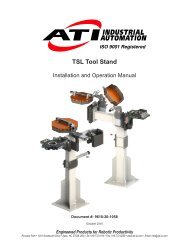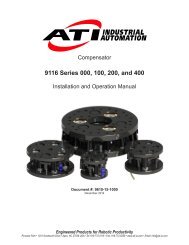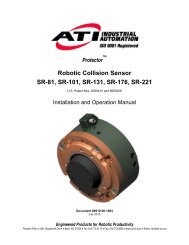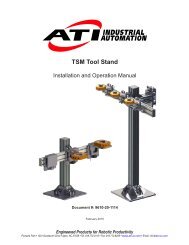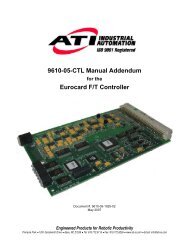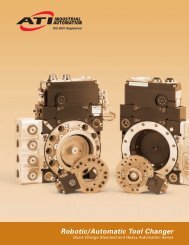Network Force/Torque Sensor System
Net F/T Manual - ATI Industrial Automation
Net F/T Manual - ATI Industrial Automation
You also want an ePaper? Increase the reach of your titles
YUMPU automatically turns print PDFs into web optimized ePapers that Google loves.
Net F/T Installation and Operation Manual<br />
Document: 9620-05-net ft-11<br />
17.2 Reducing Noise<br />
17.2.1 Mechanical Vibration<br />
In many cases, perceived noise is actually a real fluctuation of force and/or torque, caused by<br />
vibrations in the tooling or the robot arm. The Net F/T system offers digital low-pass filters<br />
that can dampen frequencies above a certain threshold. If this is not sufficient, you may want to<br />
add a digital filter to the application software.<br />
17.2.2 Electrical Interference<br />
Check the Net F/T’s ground connections if you observe interference by motors or other noisegenerating<br />
equipment.<br />
Consider using the Net F/T’s digital low pass filters if sufficient grounding is not possible or<br />
does not reduce the noise.<br />
Verify that you are using a Class 1 power supply, which has an earth ground connection.<br />
17.3 Detecting Failures (Diagnostics)<br />
17.3.1 Detecting Sensitivity Changes<br />
Sensitivity checking of the transducer can also be used to measure the transducer system’s<br />
health. This is done by applying known loads to the transducer and verifying the system output<br />
matches the known loads. For example, a transducer mounted to a robot arm may have an endeffector<br />
attached to it.<br />
If the end-effector has moving parts, they must be moved in a known position. Place the robot<br />
arm in an orientation that allows the gravity load from the end-effector to exert load on many<br />
transducer output axes.<br />
Record the output readings.<br />
Position the robot arm to apply another load, this time causing the outputs to move far from the<br />
earlier readings.<br />
Record the second set of output readings.<br />
Find the differences from the first and second set of readings and use it as your sensitivity<br />
value.<br />
Even if the values vary somewhat from sample set to sample set, they can be used to detect<br />
gross errors. Either the resolved outputs or the raw transducer voltages may be used (the same<br />
must be used for all steps of this process).<br />
17.4 Scheduled Maintenance<br />
17.4.1 Periodic Inspection<br />
For most applications, there are no parts that need to be replaced during normal operation.<br />
With industrial-type applications that continuously or frequently move the system’s cabling,<br />
you should periodically check the cable jacket for signs of wear. These applications should<br />
implement the procedures discussed in Section 17.3—Detecting Failures (Diagnostics) to<br />
detect any failures.<br />
The transducer must be kept free of excessive dust, debris, or moisture. Applications with<br />
metallic debris (i.e., electrically-conductive) must protect the transducer from this debris.<br />
Transducers without specific factory-installed protection are to be considered unprotected. The<br />
internal structure of the transducers can become clogged with particles and will become<br />
uncalibrated or even damaged.<br />
Pinnacle Park • 1031 Goodworth Drive • Apex, NC 27539 USA • Tel: +1.919.772.0115 • Fax: +1.919.772.8259 • www.ati-ia.com • Email: info@ati-ia.com<br />
B - 97



